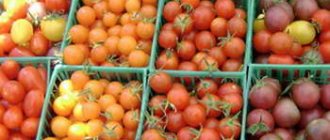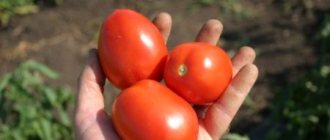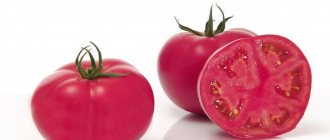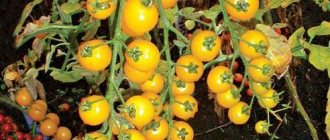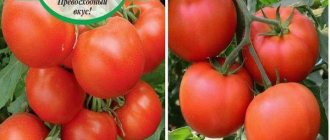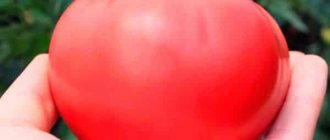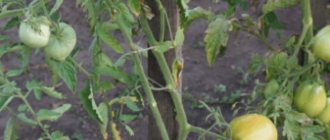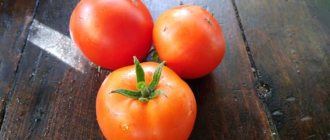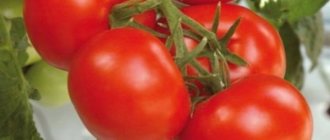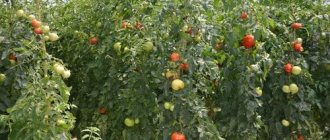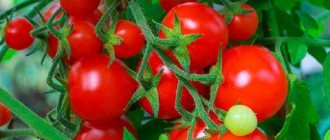Briefly about the plant and its fruits
The characteristics and description of the variety are as follows:
- The growing season of a tomato is 110 days from sowing seedlings to harvest.
- The height of the bush reaches 130-150 cm. Therefore, a garter to trellises or stakes is required. A large number of side shoots develop on the stem, which forces farmers to constantly remove shoots and tops at the lower levels of the bush. When bred in a greenhouse, the hybrid reaches a height of 170-200 cm.
- To get a high yield, it is recommended to form bushes with 2 stems. From 6 to 7 fruits are formed on the brush.
- The shape of the tomatoes resembles an orange sphere, but when you cut the berry, you can see the reddish flesh.
- The weight of a tomato ranges from 80 to 120 g.
Feedback from farmers. Those who grow the described variety show that from 1 bush you can get up to 2.5 kg of berries in greenhouse conditions. Gardeners note that the plant is immune to most diseases characteristic of nightshade crops.
Zlatov’s yield indicators do not depend on external conditions. The fruits resist mechanical damage well, so they can be transported over any distance.
In Russia, this hybrid grows in open areas in the southern regions. In the vast expanses of the middle zone and in the northern regions of the country, it is recommended to grow tomatoes in greenhouse blocks and hotbeds.
Abakan pink
On the 9th line - a variety of medium-late ripening (110-120 days from germination), determinate type (height - 70-80 cm). In a greenhouse it can grow up to 140-150 cm. The bush needs to be formed into 1-2 stems and tied up. It will ripen pink, heart-shaped fruits (weighing up to 300 g) with tasty, dense pulp. If cared for correctly, you can harvest tomatoes weighing up to 800g, rivaling in size the popular Ox's Heart.
There are many positive reviews about growing this tomato; no one criticizes it. It can be grown in Siberia, and to protect the bushes from returning spring or late autumn frosts, a light film cover will be enough. This representative of the nightshade family rarely gets sick; you will only have to ward off Colorado potato beetles from immature seedlings. In a word, it won’t cause you much trouble, and will delight you with tomatoes – both in salads in the summer and in preparations for the winter.
“I recommend Abakan pink. Unpretentious and very tasty." Lydia Domnikova-Kazakova.
Pink Pink, De Barao, Pink Honey, Giant, Sanka and Mazarin. This magnificent six has gained extraordinary popularity in Russia because of its taste, excellent keeping quality and ease of care.
Not only is the acid content in pink tomatoes lower than in red ones, they also delight gardeners with a high content of lycopene (a carotenoid that breaks down fats). More recently, it was believed that the champions in terms of the content of this pigment, which gives the leaves and fruits a blood-red color, are rich red tomatoes, best of all overripe ones.
However, Pink, Honey, Giant, De Barao, Mazarin, and with them Sanka, Flamingo and Miracle of the Earth, are superior to the usual dark tomatoes in terms of the content of this antioxidant. This means that consuming pink “tomatillos” significantly reduces the risk of developing cataracts, gingivitis, coronary disease and atherosclerosis.
Let's get to know each other!
pink pink
Small, strong, like a cucumber!
There is some “oil oil” here, because “pink” in English is translated as “pink”. This rosy-cheeked youngster (150-190 g) has a dense, aromatic and meaty appearance. In addition, this is one of the earliest salad vegetables to ripen; the period for picking berries is 65-75 days after planting the “short-growing plant”.
But strong pinks are also good in pickles and marinades, and the paste from them turns out to be a pleasant light shade.
The already well-known Paradise and Unicum were recently joined by a new hybrid (F-1) - Pink Heart.
Pink honey
So handsome! You won’t get tired of admiring!
This ruddy Honey is characterized not just by sweet and delicate “apples” in consistency, but by the almost complete absence of seeds in them. From one plant, twisted from 2 stems, in a good year you can remove up to 6 kg. strong, pink-cheeked “medics.” The height is up to a meter, and the ripening time is 100-110 days after planting in a greenhouse or open ground.
Honey is a common determinant, that is, new stepsons appear gradually and must be removed, otherwise the period of “giving away” the harvest will drag on for an indefinite time, and in open ground conditions this is not always justified, because the return should be friendly - take it off, roll it up and forget it!
Before planting, it is worth treating the area with antifungal compounds: late blight is the main scourge for Pink honey!
De Barao
Small but remote
This baby, although it weighs only 50-70 g, is resistant to late blight, unlike delicate seedless Honey. Forming in the same way as Honey in 2 stems, it grows up to 50-60 cm, and the fruits can be harvested after 120 days. The harvest will be 4 kg. from a plant.
De Barao belongs to super-determinate varieties, such as Sanka.
Neither De Barao nor Sanka require the removal of stepsons, because they stop growing after throwing out 4 or 6 brushes.
Planting in open ground no earlier than the first days of May. You can go to the greenhouse a couple of weeks earlier.
According to reviews, De Barao, grown by gardeners for several years now,
“... has never failed, always produces an excellent harvest, and quickly responds to any feeding. Cute tomatoes are very tasty and pickle well. It’s easy to roll up to 40 3-liter jars in a season!”
Sanka
Good! Oh, and our Sanka is good!
This is another super-determinant, with a height of only 50 cm and a berry weight of up to 80 g. Early it stops stretching upward and rushes to form and fill its friendly fruits, which are distinguished by their amazing “one-size”.
- These juicy balls with thick skin can be not only pink, but also red and black (it all depends on the type of Sanka)
- Sanka prefers the open ground of the Central region, zoned for Kursk and nearby regions, feels great in the Moscow region
- All 3 types of Sanka mature in 75-80 days
- The planting pattern is compacted 35x45, but they do not tolerate weeds nearby.
- Drought resistant
Mazarin
A very “bearded” sprout!
The name Signora Tomato is directly related to the cardinal and first minister of France, an Italian by birth, Giulio Mazarin. The Italian goatee is exactly the same shape as a pink tomato. Or vice versa? Or do you mean hot southern blood? The “hot blood” of this nightshade is “hot” only in the South!
The Mazarin tomato can be grown in open ground only in the southern regions of the Caucasus and Crimea. In the middle regions and Leningrad region. The Peruvian berry feels good only in heated greenhouses.
This is an F-1 hybrid with a powerful, weakly leafy stem up to 1.5 m high, with 4-5 brushes, on which large (180-200 g) red-pink “beards” flaunt, which darken as they ripen . Productivity – 4-20 kg. from 4 bushes into one stem, which grow without interfering with each other over an area of 1 sq.m.
This vegetable is extremely good fresh, as well as for making juices and sauces.
It is worth emphasizing that the main care for the red-pink “love apple” will consist of timely pinching (indeterminate variety), fertilizing with mineral complex fertilizers and abundant watering when the “beards” are forming.
Giant
Heavy, huge and beautiful!
This pink “love apple” really “suffers from gigantism”! If the stem is not trimmed in time, then “une pomme d'amour” can grow into a real tree 5-5.5 m tall!
The fruits are not of the same suit: the cluster can contain both 300 g and 2 kg berries. It will take 115-120 days to ripen, and new ones will constantly appear, so excess flowers should be eliminated in time before the ovary appears.
On 1 square it will be good for 2 single-stem plants with a mandatory garter. The fruits are consumed fresh; they are not suitable for storage or preservation.
It is not easy to get hold of the Giant seeds - the number of seeds in this fruit is tiny, and it is almost impossible to preserve them at home. It's a shame, though!
No matter which of the pink “tomatoes” finds its home on your site, these pink-cheeked berries will definitely not be able to disappoint you!
Obtaining hybrid seedlings
Seeds are disinfected with potassium permanganate or hydrogen peroxide before sowing in special soil for tomatoes. If containers previously used for similar purposes are used for propagating seedlings, they are treated with potassium permanganate. This will reduce the risk of seedlings being damaged by fungi.
Planting material is sown in boxes in the last ten days of March. The seeds are buried 10 mm, and the distance between them should be at least 30 mm. The soil should contain up to 40% peat. It is recommended to immediately transfer the sprouts that appear after 10 days to a lighted place.
After planting the seeds, the soil is treated with a weak solution of potassium permanganate. The seedlings are fed with complex mineral mixtures. To prevent rotting of the roots of the seedlings, drainage, for example, pieces of charcoal, is placed at the bottom of the container. The temperature in the room with the sprouts is maintained at +20°C.
When the seedlings are 55-60 days old, they are transferred to permanent soil. Before this operation, the seedlings are hardened off. The soil in the garden bed is prepared by adding 55 g of superphosphate and potassium sulfate, as well as 50 g of ammonium sulfate for each 1 m².
Seedlings are planted at a soil temperature of at least +13…+14°C. To do this, furrows are made in the beds 0.4-0.45 m wide and up to 20 cm deep. Before planting the seedlings, the soil is treated with Baikal or Fitosporin. The seedlings are not watered 2 days before transplanting, but they are moistened abundantly half an hour before placing the plants in the garden bed.
The first watering of the bushes is carried out 10 days after transplanting the seedlings into the beds. Then water them once a week. The hybrid planting pattern is 0.5x0.5 m. The light must fall evenly on all plants, otherwise the yield of the bushes decreases sharply.
Features of cultivation
We recommend sowing the seeds of this tomato for seedlings 60-65 days before the intended planting in the ground. Seedlings dive at the stage of two true leaves. When planting seedlings in a permanent place per 1 sq. Up to 4 plants are placed per meter of the prepared area.
In some catalogs this variety is called Zlatovo .
This is a natural variety of tomato. Therefore, we recommend taking seeds from a ripe fruit and using them for planting in subsequent seasons.
If you grew Zlatava tomatoes, please write how you liked them. What was the yield and taste of the fruits in your climatic conditions? Will you grow them again? If possible, attach to your review a photo of the entire bush as a whole or individual fruits you grew. Thank you!
Your reviews of the Zlatava tomato and additions to the description will help many gardeners evaluate this variety more objectively and decide whether it is worth planting or not.
Features of the fruit
When cut, the fruits have a reddish flesh. The average weight of a tomato is 100 grams. The fruits are round in shape and contain a small amount of seeds.
Description of the advantages of the hybrid variety:
- resistance to most tomato diseases;
- high yields regardless of environmental conditions;
- good ability to withstand mechanical damage, tomatoes tolerate difficult conditions of long-term transportation;
- Can be used fresh and for canning.
Reviews from gardeners confirm the characteristics of the variety in the form of good taste and juicy tomato pulp. Tomatoes are ideal for fresh use in salads, as an ingredient in first and second courses.
Recommendations for planting
The culture involves the use of seedling growing methods. It is recommended to disinfect the seeds before planting. When using used containers, it is recommended to pre-treat them, which will reduce the risk of disease in seedlings.
Sowing of planting material is carried out from the end of March to April. The plant is demanding of sufficient sunlight, the amount of which will determine the height and health of the seedlings. For planting, select soil with a high peat content, the amount of which should be at least 40%. The soil requires the presence of a large amount of mineral components and microelements.
When using soil from a personal plot, preliminary treatment in the form of steaming or calcination is necessary.
It is recommended to place drainage material at the bottom of the planting container, which will remove excess moisture and prevent rotting of the roots. To do this, you can use small charcoal with pieces no larger than 6 cm in size, which is mixed with the ground. Sowing of seeds is carried out at a distance of 3 cm. After planting, the soil is treated with a weak solution of potassium humate using a sprayer.
general description
The Zlatava variety is a hybrid that has orange (often yellow) fruits and incredibly beautiful reddish flesh. If you follow all the subtleties of agricultural technology, the fruits will grow juicy and tasty. Their weight will be within 100 grams.
In addition to their attractive appearance, Zlatava tomatoes differ from others in a host of useful properties:
- Resistant to most “tomato” diseases;
- Can be grown both in open ground and in greenhouse conditions;
- They show good yield in any weather conditions.
Moreover, Zlatava “tolerates” various mechanical impacts well, and it can be transported over long distances. The variety is classified as mid-ripening and can be used for canning.
The bushes of this tomato can grow up to 1.5 m in height, and the most abundant yield can be achieved after the formation of 2-3 plant stems. Zlatav also needs to be pinched and tied up.
Tomato Soldatovo. Description
Despite the large number of exotic shapes and colors of tomatoes, the Soldatovo tomato is especially popular in the CIS countries. This variety is valued for its neat shape, firm and fleshy structure. It is also interesting because it can be grown both in the garden and in the greenhouse. That is, it turns out that it can be grown on an industrial scale. We will tell you further how to harvest a good harvest of these tomatoes.
What does a Soldatovo tomato look like?
It has a classic color - red. When grown in greenhouse conditions it may have a pink tint. It is especially valued for its solid structure and convenient elongated cubic shape. It is convenient to cut and transport. The average weight of one tomato is 250-300 grams, and its size does not exceed 10 cm. The height of the plant rarely exceeds 1.8-2 meters in height. Therefore, for a good harvest, we recommend tying it to a support.
What harvest can be harvested in the future?
With the right agricultural technology and careful preparation, you can harvest up to 5 kg of tomatoes from 1 bush. Considering that the ripening period from the moment of planting in the ground is 2 months, at least 4 kg of tomatoes can be harvested from one bush. The average growth on one branch is up to 4 units of tomatoes. However, such a result is possible under optimal conditions and timely stepsoning. Based on our experience, it is optimal to use no more than 2 branches for this variety.
How to grow
The greatest results from cultivation can be achieved using the greenhouse method. But, of course, the Zlatava tomato can be planted in a garden in an open area. With the first option, you need to constantly monitor the temperature and humidity.
There are often cases when the “infection” enters the garden from seeds and containers. Therefore, seeds also need to be disinfected, and used containers should be treated.
When to sow
Zlatava should be planted from March to April, presumably 1.5 months before transplanting into a greenhouse or soil. The closer to warmer times you sow, the higher the sun's activity will be, and the faster the plants will grow.
The soil
It should consist of 40% peat, 25% specially purchased high-quality soil, fertilized with useful minerals and trace elements, as well as 30% steamed garden soil.
Sowing technology
In the container for seedlings (there should be drainage in the lower part to remove excess moisture), you need to pour 6 cm of fine charcoal, pre-mixed with planting soil. Mix the fractions thoroughly and compact.
Then, at a distance of about 3 cm from each other, you need to make grooves in the soil. Their depth should be no more than 1 cm. Now you can moisten the soil with a weak solution of potassium humate. The most convenient way to do this is with a spray bottle.
Now you can put tomato seeds in the “trenches”. The distance should be about 2.5 cm. With a weak humate solution, you need to re-moisten the seedlings slightly pressed into the soil.
You need to cover the seeds with dry soil in a 1 cm layer, which then needs to be crushed. Next, the containers are sent for maturation to a dry place, with an air temperature of about 30 degrees. This variety requires heat.
Care and transplantation
After the plants sprout their first shoots (appear approximately 10 days after planting), you need to remove the container with the seedlings and place the tomatoes under a source of constant light for 4 days.
I. Hybrids
Hybrid tomatoes are virtually guaranteed to be resistant to diseases and bad weather conditions, which is something that non-hybrid varieties suffer from. Greenhouses and greenhouses are valued for storing heat, but in them tomatoes can suffer from too high temperatures and sudden temperature changes. In recent years, world selection has been aimed at producing “heat-resistant” hybrids with a reliable guarantee of ovary production.
Hybrids are especially helpful in a greenhouse or a small garden plot where there are no real opportunities for crop rotation and diseases are prevalent. Selection successes demonstrate confident resistance to various types of infections - viral (especially the most dangerous tobacco mosaic virus), fungal, bacterial. In addition, the hybrids have uniform fruits and consistently high yields.
Tomato Incas F1
One of the best hybrids for canning whole fruits without skin. Popular early high-yielding bush hybrid. The plant is medium-sized, compact.
Tomato from the Dutch company Numens, zoned in Russia; entered into the state register in 2000. Mid-early hybrid (105 days) of meter-high vegetables, determinate. Very high resistance to fungal diseases has been recorded. The fruits are 80-100 g, dense, bright red, pepper-shaped, fleshy, uniform, tolerate sunburn well, are very easy to ripen, transported over long distances without loss of quality.
Tomato Torquay F1
Dutch hybrid from Bejo Zaden; in the Russian register since 2007. Mid-season tomato (119-123 days from germination to ripening), bush type - determinate, maximum height 100 cm. Forms abundant multiple clusters with fruits weighing 60-140 g. Dense tomatoes withstand long-term transportation, excellent in pickling and pickling matters.
Tomato Mariana F1
The tomato was created in the French branch of the Japanese company Sakata (the image of the woman Mariana is a symbol of the French Republic). The breeders of this agricultural company are often suspected of producing GMOs, but so far without real evidence. Mariana is a mid-early determinate hybrid. The fruits are similar in shape to Incas - also elongated-oval, perfectly smooth, super dense.
Tomato Bagheera F1
Hybrid from the leading French seed company Cloz. Included in the Russian seed register in 2007.
Early high-yielding hybrids are a real boon for the garden. They are cold-resistant, do not need pinching or tying up, and practically do not get sick. The ripening period is marked as medium-early; determinate bush. The fruit is round, flattened on top, ribbed, weight ranges from 80-220 g. The hybrid is resistant to soil drought and nematode, more suitable for regions located in the south. Does not suffer from fusarium and verticillium wilt.
Tomato F1 Semko 2005
The tomato is suitable for open ground and under film shelters (greenhouses). Determinate, medium-sized, compact. Resistant to soil salinity, drought, high temperatures, grows well in open ground in both southern and northern regions. Vegetables practically do not suffer from viral and fungal diseases, even late blight.
Tomato F1 Semko 2010
Included in the state register in 2010. Ultra-early ripening determinate hybrid - 85-88 days pass from the sprouting of green vegetables to the coloring of fruits. The first brush is formed immediately after the sixth leaf grows. The fruits are incredibly dense for such an early tomato, and are by no means small - 130 g. The shape is round hearts with a beautiful pointed tip.
The newest indeterminate hybrid (on the register since 2015) - tested by us, everything is fine - created taking into account all possible greenhouse disasters. Firstly, it sets well even in the heat, as well as during temperature changes. Secondly, it is tolerant of problematic soil substrates. Thirdly, it shows high resistance to viral, fungal and bacterial infections.
The yield of vegetables varies between 20-30 kg/1 square meter. Mid-early hybrid (100 days from green shoots). The clusters begin to form after 7-9 leaves, each bears 5-6 tomatoes in the shape of rounded hearts, smooth, beautiful, attractive orange color. The weight of the “heart” is 160-190 g. The pulp contains a high percentage of dry matter, sugars, and carotenoids. The fruits are quite dense and do not wrinkle during transportation. Purpose: salad. Created as an orange variant of another hybrid - Tomato Pink Spama.
Bushes of unlimited growth, with dense foliage. Mandatory shaping is required, including a garter. Hybrid of medium early or medium ripening period (112-118 days). Clusters of 6-8 tomatoes weighing 130-150 g. The fruits are plum-shaped, slightly tapering downwards. They are deep red in color, thick-skinned, with a high percentage of dry matter.
Tomato Empire F1
Indeterminate hybrid of a new generation, in the state register since 2011. Medium-early (100 days - 2 days - from germination). The plant is tall, much taller than other types of tomatoes. Therefore, the tomato requires gartering and pinching. Tomatoes are oval-shaped with a spout, weight ranges from 80 to 140 g. On average, 9 kg are obtained per bush. The color of the fruit is red-orange. The skin and pulp are dense. Can be stored for 6-7 weeks. In greenhouses people do not suffer from viral and fungal infections.
On the register since 2015. The bushes are semi-determinate, beautiful, a meter and a half high. Suitable for any soil - open or closed. Plants require pinching. Multiple clusters bear up to 30 fruits with a sweet taste and a perfect “strawberry” shape. The weight is typical for classic cherry tomatoes - 25 g. Thanks to the strong skin, the fruits can be stored for a long time. Early hybrid: ripe fruits appear 91-93 days after the sprouts emerge. The plant is resistant to Fusarium wilt.
Tomato F1 Kaspar
The bush is short, usually up to the first cluster, 60 cm. The fruits of the plants are cylindrical with a spout, the length varies around 11 cm, and the weight is 95-115 g. They are very dense, without juice. It is convenient to pickle them assorted with cucumbers of a similar size.
The average ripening period is 115 days. The hybrid is intended for open ground, or is planted under low shelters; We plant three to four vegetable bushes per square.
Tomato Aunt Valya F1
Valya f1 tomatoes are early-ripening, tall hybrids with average yield. The bushes easily and quickly reach a height of 200 cm. In the register since 2015. Productivity is within 20 kg per square meter. On average, one bush produces 7 kg of tasty and beautiful tomatoes. Tomatoes ripen simultaneously, reaching 200-250 g in weight.
The fruits have a regular round, slightly oblong shape. The scope of use of tomatoes is very wide. Salads are prepared from the first fruits. As the volume of the harvest increases, the fruits are used for winter harvesting, as well as juices, ketchups, pastes, sauces and lecho. Tomatoes retain commercial quality for a long time and tolerate transportation and long-term storage well.
Secrets of agricultural technology
The first stage is preparing the beds. In the spring, before planting our tomatoes, the soil must be treated with mineral fertilizers. For 1 sq.m. worth entering:
- Superphosphate – 55 g;
- Potassium sulfate – 55 g;
- Ammonium sulfate – 50 g.
After adding these substances, the soil must be loosened. It is very important to remember that tomatoes can be planted at an air temperature of at least 13 degrees. The process is further divided into the following stages:
- “Trenches” are made for seedlings. This is much easier than digging one hole for each bush. The width of the grooves should be about 30 cm, the depth – about 20 cm. If planting is done in “stitches”, then the distance between the grooves should be 65 cm;
- A couple of days before the intended planting of bushes, all trenches need to be walked with a spray bottle and treated with nitrogen-free fertilizer. Calculation – 2 tbsp. per 1 m of trench;
- Now you can fertilize the soil with Fitosporin, Trechodermin and Baikal. Important
! You should not use only Fitosporin and Trechodermin in one area.
After cultivating the soil, the trenches should be covered with any materials for a couple of days to maintain soil moisture. Before directly planting the bushes in the grooves, you need to add 2 tbsp. l. Borofoski, and mix it with the same fertilizers that were used in the last paragraph above. Then the holes are covered again.
Planting is best done in cloudy weather. Tomatoes should not be watered in front of it for 2 days, and the holes should be moistened generously with water 30 minutes before planting. The seedlings are placed in the furrows at a distance of 45 cm from each other.
How to plant:
- Each bush is carefully removed from the container;
- Placed in the soil with the roots facing south and the crown facing north. It is best to plant bushes at a slight angle. But, the roots must be below the top;
- The soil from the container is poured into the soil, the rest of the soil is taken near the trenches. It is important to press it as carefully as possible to the roots so that there are no air voids in the soil;
- The bush is re-moistened with calcium nitrate diluted with water (1 tbsp);
- The tomatoes are covered with the remaining soil and are no longer moistened. Outwardly, it will seem that the ground is dry, but as soon as the sun rises, it will become noticeable that they are rising.
The best varieties of tomatoes: varieties and characteristics.
A wide variety of tomato varieties allows you to choose the one you want. The shapes of the fruits of this plant are sometimes surprising. They can resemble plum, cherry, peach, currant, pear, lemon, egg. The varieties also differ in color: from the usual red to yellow, purple, orange. And the range of sizes is amazing: from a few grams to 2 kg (Giant).
The Agata tomato has a color, weight and shape that is familiar to the eye of a gardener and just a consumer. Yes, and growing it on your own plot will not be difficult.
Since agricultural techniques are not too complicated, even a novice vegetable grower can get a good harvest of this vegetable, which contains 2-3% sugar, organic acids and a whole range of vitamins, without much expense.
Early variety. Fruiting occurs on average three months after the appearance of the first shoots. Agata bushes are determinate (that is, having limited growth). The fruits are red, slightly flattened, round. Weight up to 110 grams. The taste is sweet with a slight sourness.
With proper agricultural cultivation techniques, you can get up to 4 kg from one bush, which is similar to the Auria variety. From 3 to 6 tomatoes are tied on a brush. This variety can be grown both in open ground and in greenhouses.
Universal application, average transportability.
With proper agricultural cultivation techniques, you can get up to 4 kg of Agata variety tomatoes from one bush
Features of the variety
Agatha is not much different from other early varieties, but there are still some features:
- low growing bushes. The tallest can reach half a meter.
- early ripening will slightly protect the bushes from late blight. But this is only possible if the lower leaves do not come into contact with the ground and the gardener carries out all preventive measures on time;
- the fruits are the same in size and weight.
In its entirety, this creates an attractive picture for buyers. Tomato bushes are stunted with fruits of the same size and weight
READ MORE: Tomato Winner: characteristics and description of the variety with photos
This plant has a strange fate. Homeland: Ecuador and Peru. There it was not considered edible and was called “tomatl”. The French gave it another name - “love apple”, because the fruits of this vegetable reminded them of a heart. Or in French "pomodoro".
In the 80s of the 20th century, the famous Russian gardener R.I. Schroeder, describing the tomato, gave it the name Cupid Apple. And in Russia and near abroad the name both tomato and tomato has taken root. Over the past hundred years, many worthy varieties have been developed. One of them is Agatha.
Its appearance since 1987 is the result of the work of Russian breeders.
Ecuador - the birthplace of the Agata tomato
Recommended for cultivation in the temperate and southern zone of the country: the Middle Volga region, the North Caucasus, the East Siberian and West Siberian regions.
Agatha has both its advantages and disadvantages:
- early variety. This helps to avoid massive damage to bushes by late blight. But only with timely prevention;
- determinate bushes. That is, they do not require pinching, pinching or tying to a support. It depends only on the desire of the gardener to lift them onto a trellis or let them grow without tying them up. True, in order to protect against infection by fungal diseases and achieve even illumination of the leaves and fruit, it would be better to raise it to a standard;
- You can grow a good harvest both from seed and by seedlings.
Fruits well in open ground and in greenhouses. The Agata variety has determinate bushes
Among the biggest disadvantages is susceptibility to fungal diseases, although breeders describe this variety as moderately resistant.
Growing
In order to get a good harvest of tomatoes, the soil must be well prepared and the area must be allocated after certain predecessors.
Preparing the beds
Digging of the site is carried out in the fall after adding humus, compost, leaf soil, etc. They shovel the earth to the size of a bayonet and a half, without breaking the blocks. In the spring, the top layer is loosened with a cat hoe.
The blocks are broken and the area is leveled. Clay and loamy soils are not cultivated with particular care, without crushing the soil too much.
Since after heavy rains a dense crust may form, which will prevent seedlings.
Condensed plantings have a positive effect on the harvest. They improve the microclimate and increase air humidity. Onions, beans, and asparagus have a good effect on Agata tomatoes.
Seed preparation
There is a very good folk saying that says that a bad seed cannot produce a good tribe. That's why:
- It is better not to buy seed material from random people.
- Strive to grow zoned varieties.
Before sowing seeds, you should estimate how many you will need. To propagate tomatoes, 2–3 grams per ten square meters is enough. Before planting, they are calibrated, disinfected, coated (enriched with nutrients), and soaked. It is possible through bubbling. Pre-sowing stimulants are used (0.1% nicotinic acid solution is the best for tomatoes) and germinated.
Germinated seeds are planted in moist soil.
Growing seedlings
Tomato seeds are not afraid of cold weather. Therefore, as soon as the soil warms up a little, you can sow them in open ground.
Seedlings are grown in greenhouses, greenhouses, and even on window sills, if the area of future planting is not too large. In order for the seedlings to be ready for planting in open ground by the beginning of May, the seeds are planted in early March. But to obtain an early harvest of Agata tomatoes, they are planted in greenhouses, counting approximately 3 months before transplanting to a permanent place.
In the open ground
Seedlings are planted when the threat of spring frosts has passed. But due to the fact that they can be observed even in May, you need to have a plastic film just in case to protect the plantings from freezing.
Early varieties, which include Agata, are planted in the second or third ten days of April. Before planting, the holes are watered. If these are grooves, then they are filled with water. The distance between plants should be about 30 cm, and the row spacing should be 50 cm.
Gardeners often follow the lunar calendar when planting tomatoes.
When planting a tomato, the distance between plants should be about 30 cm, and the row spacing should be 50 cm.
The seedlings are planted in the holes 3–4 cm deeper than they grew in the greenhouses.
At first, seedlings need to be watered at least once every three days. Further care consists of:
- loosening the soil;
- weeding;
- feeding;
- glaze;
- pest and disease control.
The first feeding should be two weeks after planting. The second is when fruiting begins. The third - two weeks after the second. The rate of use of mineral fertilizers for the first feeding per 10 liters of water:
- 20 grams of ammonium nitrate;
- 70 grams of superphosphate;
- 50 grams of potassium salt.
For the second and third feedings, nitrogen fertilizers (ammonium nitrate) are not used.
Vegetable growers often forget that tomatoes come from South America and are not from humid areas. Therefore, they normally perceive periods without abundant irrigation. It is better to water Agata variety tomatoes along the grooves at intervals of 10 days. Water consumption - 500 liters per 10 square meters of soil. You can read about how often you need to water tomatoes here.
To enhance and accelerate the formation of fruits, plants are planted. That is, they pinch off the shoots that form in the axils of the leaves.
To obtain an early harvest, seedlings can be planted in ditches. To do this, they are dug up to 40 cm deep, manure is poured in, then turf soil is added, and the plants are planted at an angle.
To enhance and accelerate the formation of fruits, plants are planted
In greenhouses
The soil for planting is dug deeply, after adding rotted humus. Seedlings must be watered before planting. And they make fairly wide holes to avoid damage to the root system. Planted together with a lump of earth so that it does not exceed the level of the soil surface. For more information about how to grow tomatoes in a greenhouse, read this article.
https://www.youtube.com/watch?v=EI-x5TbTcmU
If the seedlings were grown in peat pots, then there is no need to remove them from there.
During the rooting period of the plant, the soil should be moist.
Features of caring for agate varieties in a greenhouse:
- garter. The plant is not tall, it grows up to half a meter, but it is still better to tie it up;
- stepsoning. Shoots form in the axils of the leaves. While they are small, you can break them out in the morning. It is at this time that plants are turgid (contain a lot of moisture). If the shoots are already large, then it is better to cut them diagonally with a sharp knife.
There is no need to pinch the tops of plants of this variety.
Plantings in greenhouses are fed with liquid fertilizers and carried out along with watering. The fruits are collected as they ripen.
READ MORE: Standard raspberry varieties or raspberry trees: description, reviews, planting and care rules
Harvesting occurs as the tomato ripens
Healthy plants are less affected by diseases and insects. But crop losses are still high. Therefore, it is necessary to carry out preventive measures, and if you see damage on the bushes, you should establish their cause and take appropriate measures as early as possible. The Agata variety suffers most from such diseases and pests.
Diseases
- Late blight.
The most common disease of tomatoes. Gradually the leaves turn black, and then the fruits. The disease is caused by a fungus. This may be a consequence of changes in humidity and air temperature. And also dense plantings.
The Agata variety is moderately susceptible to this fungal disease. Therefore, both preventive measures and the use of chemicals to combat late blight are needed.
Ignoring the signs can lead to complete loss of the crop.
- Viral diseases (leaf mosaic). Characteristic signs: spotting, leaf curling. It infects aphids and nematodes, and the disease also appears after planting infected seeds. The affected plant must be removed immediately.
- Bacterial wilt (bacteriosis). The bush literally begins to wither in a short period. Sick plants are removed.
- Root rot.
Caused by fungi. Main signs: death of roots and basal stem. If a vegetable grower sees this, then the affected plants can be watered with a solution of zineb. Tomatoes that are very affected by the disease are removed from the garden and burned. Manifestation of tomato root rot
Pests
- Scoops. The larvae of moths eat up the roots of plants and they die. Before planting seedlings, the soil is treated with diazinon.
- Medvedka.
Propagates well in moist soils. It damages not only the seedlings, but also the tomatoes lying on the ground. To combat this, you can spread small piles of humus and compost around the garden closer to winter. During frosty periods, rake them out. These insects are waiting for warmth there. They can be easily destroyed.
